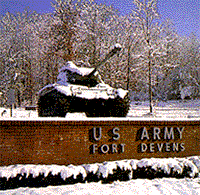Base History \ Arrival
https://www.devens.army.mil/Newsletters/2015welcomepacket.pdf
Fort Devens
31 Quebec Street
Building 679, Box 1
Fort Devens, MA 01434-4479
Phone 978-796-2126
Phone (DSN) 312-256-2126
Fax 978-796-3572
Fax (DSN) 312-256-3572
Fort Devens, New England's Village Green. Fort Devens' 82 year tradition of service to the nation lives on at Fort Devens. Apple orchards, quiet countryside, and a small town, rural atmosphere are all wonderful ways to describe the Fort Devens area. Excellent educational facilities, both public and private, provide families with a sound foundation for raising children. Exceptional health care is available in both area hospitals and clinics and in the nearby Boston area. Commuters to Boston find it a one hour drive or train ride from Fort Devens with commuter rail stops in adjacent towns.
We remain "New England's Training Site of Choice." Fort Devens is located in the Montachusett Region of north central Massachusetts, which is approximately 35 miles northwest of Boston off Route 2 and only 7 miles from I-495. The region is bordered by New Hampshire to the north, metropolitan Worcester to the south, Franklin County to the west and the Middlesex County to the east. Fort Devens lies in northern Worcester and western Middlesex counties surrounded by the towns of Ayer, Shirley, Lancaster, and Harvard.
The region is mostly rural residential, however, there are surrounding industrial centers in the cities of Worcester, Fitchburg, and Leominster. Fitchburg and Leominster comprise the largest communities in the region.Fort Devens includes approximately 5,220 acres. The remainder of the former Fort Devens has been transferred to the local reuse authority known as MassDevelopment, and other Federal agencies. These include the Federal Bureau of Prisons, the U.S. Fish and Wildlife Service, the Department of Labor and Shriver Job Corps Center. Although, Fort Devens is a reserve installation, we partner with Hanscom AFB for many active duty functions, such as base housing, schools and family support services.
Devens is considered a high cost of living area. Cost of Living Allowance (COLA) is applicable. The further East on "Route 2", heading toward Boston, the higher the cost. The average cost of a house is $380,000.00. Apartments are expensive and rental houses are scarce. Both oil and gas prices for heating have risen over the past year. Fort Devens operator number is 978-796-3911.
History
Created by the demands of World War 1, Fort Devens has been a part of the New England scene. It was named in honor of Brevet Major General Charles Devens, a Massachusetts son who served in the Union Army during the Civil War, and later was named Attorney General during the Presidency of Rutherford B. Hayes. A reception center for selectees following the end of World War I, the camp was designated a demobilization center. Camp Devens processed more than 100,000 selectees into the Army, and as a demobilization center, processed more than 150,000 men out of the Army. From 1922, through the summer of 1931, Camp Devens was utilized as a summer training camp for New England-based National Guard troops, Reserve Units, ROTC cadets and Citizens' Military Training Camp (CMTC) candidates.
Following the outbreak of World War II in Europe, plans were formulated to increase the U.S. Army. In 1940, the first peace-time draft in the United States was instituted, and Fort Devens was designated a reception center for all New England men destined to serve for one year as " draftee." Three divisions trained at Fort Devens during World War II. The 1st, 32nd and the 45th, along with the Fourth Women's Army Auxiliary Corps (WAAC) Training Center opened on post in April, 1943. Following the end of World War II, Fort Devens once again was designated as a demobilization center. On June 30, 1946, Fort Devens, for the second time in its history, was again put on caretaker status. The U.S. Army reactivated Fort Devens as a class one installation in July, 1948. With the outbreak of the Korean Conflict, Fort Devens was designated as a reception center for the third time in history.
In its 79 years of service to the country and the New England area, more than 400 units (including a U.S. Navy Air Squadron) have called Fort Devens home. In 1991, the Base Realignment and Closure Office recommended that Fort Devens' active duty mission be eliminated and a small reserve enclave and training area be maintained for use by the Reserve and National Guard. Fort Devens closed its doors as an active duty installation, March 31, 1996, and the next day, it was business as usual at Devens (RFTA). Effective May 2007, the Devens Reserve Forces Training Area was renamed Fort Devens. Today, the Fort Devens, MA supports more than 25 reserve and active component units located there. For more information, visit the Fort Devens homepage.
A reception center for selectees following the end of World War I, the camp was designated a demobilization center. Camp Devens processed more than 100,000 selectees into the Army, and as a demobilization center, processed more than 150,000 men out of the Army. On September 1, 1921, Camp Devens was declared excess to the U.S. Army's needs and was put on caretaker status. From 1922, through the summer of 1931, Camp Devens was utilized as a summer training camp for New England-based National Guard troops, Reserve Units, ROTC cadets and Citizens' Military Training Camp (CMTC) candidates. In the summer of 1928, construction of the first two permanent buildings got underway, one a regimental barracks and one a battalion barracks. In 1929, Robert Goddard, pioneer in rocketry, used the post for his rocket tests.
In September, 1931, the 13th Infantry Regiment was garrisoned at Camp Devens along with three companies of the 1st Tank Regiment. The following month the camp was declared a permanent installation, and in 1932, it was formally dedicated as Fort Devens. At that time, the three tank companies were inactivated and immediately reactivated as the 3rd Battalion, 66th Infantry (Light Tanks). A limited building program continued at Fort Devens, along with a post beautification program throughout the 1930s, with much of the funds coming from the Works Progress Administration (WPA) and Civilian Conservation Corps (CCC).
Following the outbreak of World War II in Europe, plans were formulated to increase the U.S. Army. In 1940, the first peace-time draft in the United States was instituted, and Fort Devens was designated a reception center for all New England men destined to serve for one year as "draftee."
A massive building program was instituted at the post in 1940. More than 1,200 wooden buildings, including two new 1,200-bed hospitals, were constructed at a cost of $25 million. In 1941, the Fort Devens airfield (Moore Army Airfield) was built at a cost of more than $680,000. The Whittemore Service Command Base Shop was constructed in 1941-1942 and when it reached its peak load of repairing all damaged U.S. powered vehicles in the First Service Command area, it was known as the largest repair facility in the world.
World War II
Three divisions trained at Fort Devens during World War II. The 1st, 32nd and the 45th, along with the Fourth Women's Army Auxiliary Corps (WAAC) Training Center opened on post in April, 1943. Three months later, the WAAC became the Women's Army Corps (WAC). In February 1944, a Prisoner of War Camp for 5,000 German and Italian soldiers opened at Fort Devens. It remained in operation until May 1946. In addition to training combat soldiers in World War II, Fort Devens was the home of the Chaplain School, the Cook and Baker School and a basic training center for Army nurses.
Following the end of World War II, Fort Devens once again was designated as a demobilization center. On June 30, 1946, Fort Devens, for the second time in its history, was again put on caretaker status. On September 1, 1946, the post was utilized as an extension of the University of Massachusetts so veterans could continue their education.
The U.S. Army reactivated Fort Devens as a class one installation in July, 1948. With the outbreak of the Korean Conflict, Fort Devens was designated as a reception center for the third time in history. No divisions were assigned to Fort Devens during the 1950s but two regimental combat teams were assigned, along with two signal battalions; the United States Army Security Agency Training Center and School; the 56th AAA Brigade; the First Army Chemical Defense School; and many smaller units. During the Vietnam Conflict, the 196th Light Infantry Brigade and the 1st and 2nd Battalion, 2nd Brigade, were sent from Fort Devens to Vietnam. During Desert Storm, Fort Devens prepared active, reserve and National Guard units for deployment to Saudi Arabia.
In its 94 years of service to the country and the New England area, more than 400 units (including a U.S. Navy Air Squadron) have called Fort Devens home. In 1991, the Base Realignment and Closure Office recommended that Fort Devens' active duty mission be eliminated and a small reserve enclave and training area be maintained for use by the Reserve and National Guard.
Fort Devens closed its doors as an active duty installation, March 31, 1996, and the next day, it was business as usual at Devens Reserve Forces Training.
Effective May 2007, the Devens Reserve Forces Training Area was renamed Fort Devens.
Mission
The Garrison exists to support military training and tenant activities. Our customers come first and our workforce is flexible to support their requirements. Our vision is to be The Training Area of Choice for New England units.





